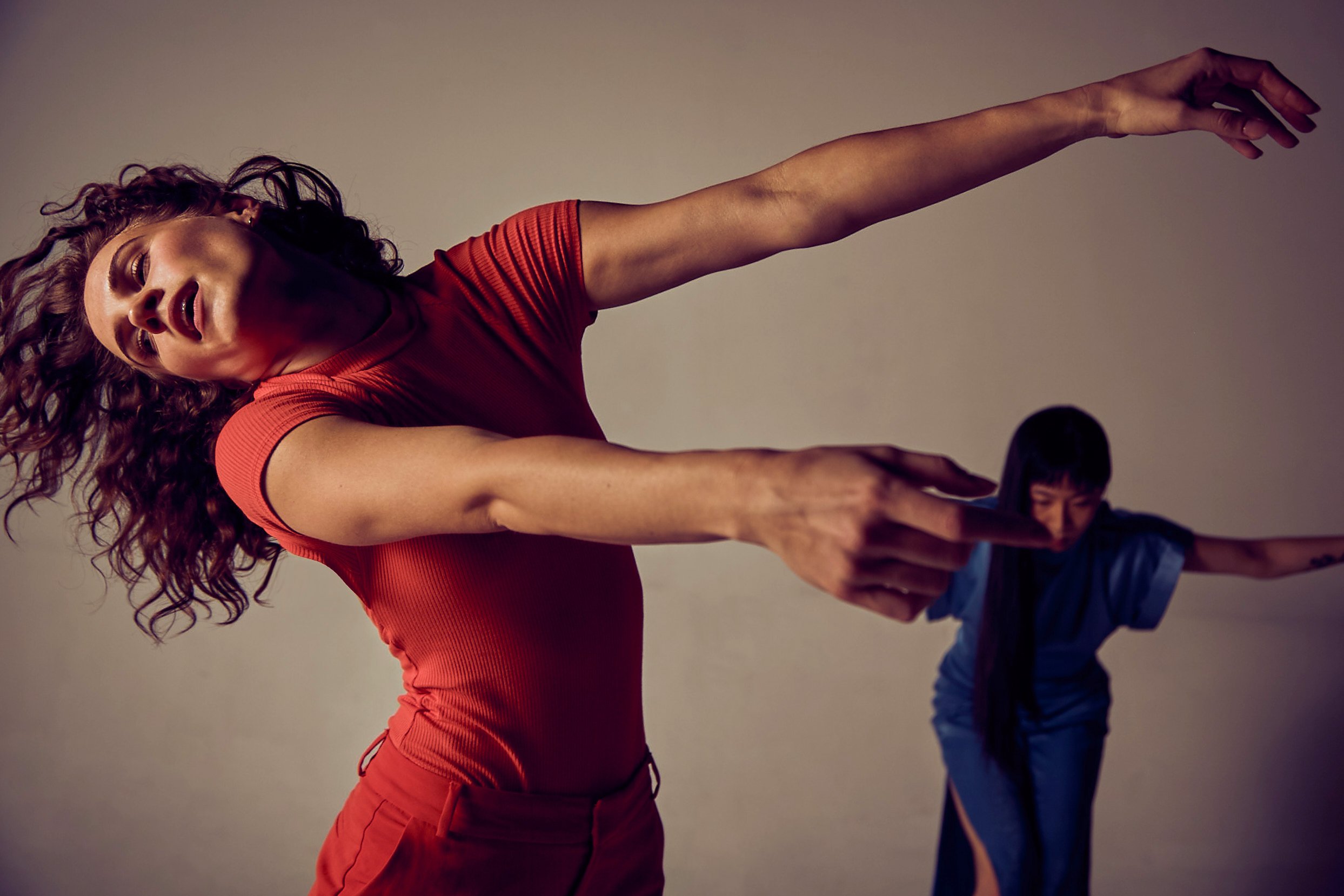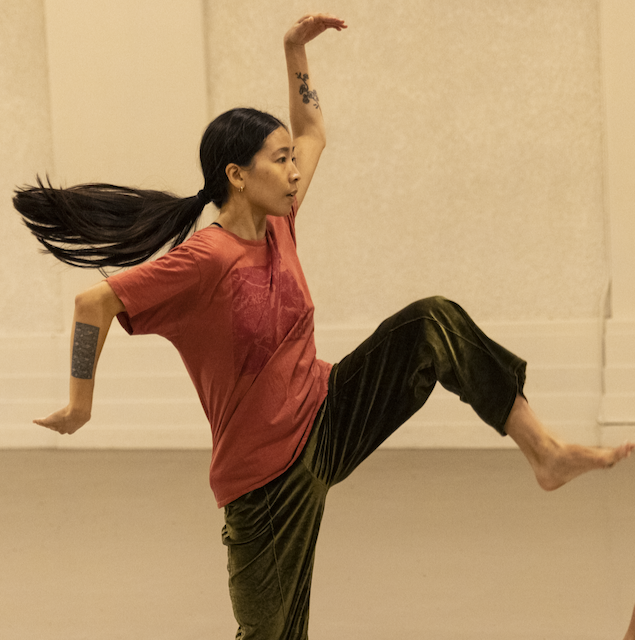
Delicate Power
Delicate Power examines the different ways we yield, share or exert power. It is an investigation of command without force.
“The result suggests that while the ground is shifting, the women standing on it are powerful in their adaptability, and voluminous in their response.” “Successive power that makes space for the multiplicity of voices on the stage." - Melanie George, Dramaturg
Notes on Delicate Power by Melanie George
From my first rehearsal attendance in summer of 2021, I experienced Delicate Power as a set of linked vignettes. Modular in process and feel, neither the dancing nor dancemaking is linear. This is purposeful, as Simoneau is not intending to exact a statement on the power of women. The coupling of a cast of women with “delicate” is not to imply fragility. It is more accurate to view “delicate” as a synonym for “fine,” meaning acute or honed. Add to it the suggestion that softness and pliancy have a unique power unto themselves. Delicate Power is not a journey or a manifesto. Somehow both blurry and fixed, it is a potential afterimage that lingers after exposure. There is tension within the work, but it comes from outside forces often met by the dancers with ferocity and refinement. This is an ungovernable, collective power, but it is not being enacted on another. There is togetherness, but not sameness, as each dancer is easily identifiable by their choice making within the work. The scenes in the piece are effortful and tone specific with morphing textures and responses. Tableaus form and reform. Dancers are constantly arriving and departing, often curvilinear, sliding and slicing, while framing themselves or others. The result suggests that while the ground is shifting, the women standing on it are powerful in their adaptability, and voluminous in their response.
The seeds of Delicate Power were sown in 2019 as Simoneau began to consider the many ways in which we define power, and how it manifests in the lives of female identifying people. As it makes its debut in 2022, it feels like a work marking a new era in Simoneau’s choreographic history. Related to earlier pieces, yet different. In the past, I discussed her choreography as a lens through which you might consider power, strength, gender, and size. A lens on a world where language often has double meaning. All still true, in my estimation. However, by necessity, the process for making a new work between 2019 and 2022 is different. In her latest piece, we see group unison deployed as a theme of the work, and also because unison movement dynamics were denied for so many of us during much of the time in which this piece was made. In the choreographic history of Hélène Simoneau Danse this work is decidedly of the now… and the after.
Composer Caroline Shaw created a score with vocals and rhythms that are at once airy and staccato. Shaw gave Simoneau agency to rearrange the passages and tracks toward finding the appropriate mix. Of Shaw, Simoneau notes, “She’s not precious about the final say. It’s a playful process.” Though the result is cool in tone, some of that playfulness found its way into Simoneau’s development process. Culled from hours of improvisation, rather than sculpt phrasework on her own body, as she did pre-2020, it is through the dancers that the material was developed and transposed. Successive power that makes space for the multiplicity of voices on the stage.
As a contemporary dance maker, Hélène Simoneau has an acute relationship with form and architecture. This is notable not only for the craft with which it is deployed, but also because this sets her apart from many of her peers who are enchanted by formlessness as an indicator of a contemporary voice. Simoneau frames the dancers and the dance through ever-morphing lines and curves that are picturesque, but not without weight. Her love of form is not a substitute for substance and abstraction. Instead, through it, we see a lineage of classical training brought forward into the 21st century, to engage with the complexity, vulnerability, and uncertainty of our contemporary world.






DELICATE POWER
Premiered June 2022 at the American Dance Festival in Durham, NC.
Concept and Direction: Hélène Simoneau
Choreography: Hélène Simoneau in collaboration with the performers
Original Music: Caroline Shaw
Performance: Maya Addie, Mikaela S. Brandon, Niara Hardister, Matilda Sakamoto, Thryn Saxon, Jie-Hung Connie Shiau, Savannah Spratt, Can Wang, Mayu Nakaya
Dramaturgy: Melanie George
Costume Design: Quinn Czejkowski
Lighting Design: David Ferri
Additional Contributors:
Mariah Anton, Teigha Beth Bailey, Jazmine Colón, Carly Greene, Dominica Greene, Laura Gutierrez, Alex Haquia, Hannah Howell, Maggie Joy, Amanda Knight, Ponpavee Kwunchaithanya, Catie Leasca, Gabrielle Loren, Kyana Lyne, Reché Nelson, Teresa M. Noonan, Kali Oliver, Moscelyne ParkeHarrison, Payton Primer, Alisya Razman, Hannah Staton, Danielle Swatzie, Isabel Umali, Claire Westby, Haley Williams
All of the artists above have collaborated to inspire the development of this piece.



THE MAKING OF
Video by Nel Shelby Productions



THANK YOU
Delicate Power by Hélène Simoneau is co-commissioned by ADF, with support from the Doris Duke/SHS Foundations awards for New Works. The creation of Delicate Power was made possible, in part, by a New York City Center Choreography Fellowship, with support from Doris Duke Charitable Foundation. Music commissioned by the Charles and Joan Gross Family Foundation. Our ADF residency is funded in part by a grant from South Arts in partnership with The Andrew W. Mellon Foundation. The project is also made possible, in part, with support from: The Guggenheim Foundation; National Endowment for the Arts; the New England Foundation for the Arts' National Dance Project, with lead funding from the Doris Duke Charitable Foundation and The Andrew W. Mellon Foundation; New Music USA; the O’Donnell-Green Music and Dance Foundation; and by the North Carolina Arts Council, a division of the Department of Natural and Cultural Resources, with funding from the National Endowment for the Arts. Our Wortham Center for the Performing Arts residency is funded in part by a grant from South Arts in partnership with The Andrew W. Mellon Foundation.
Photos: Photos Whitney Browne, Maria Baranova, Peter Mueller

